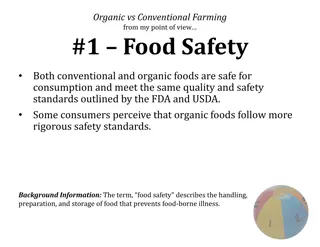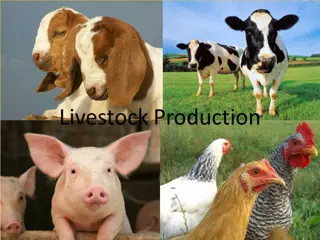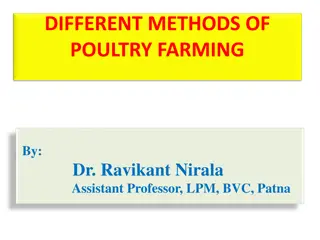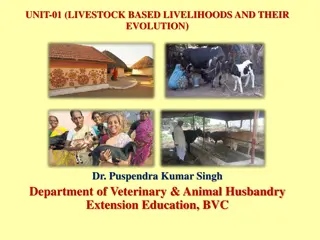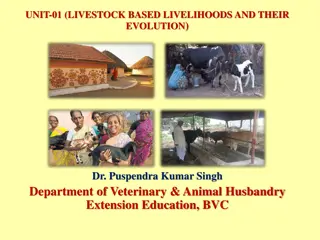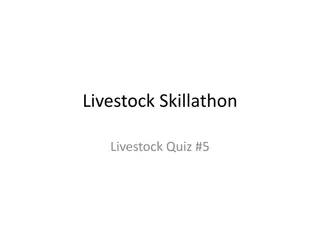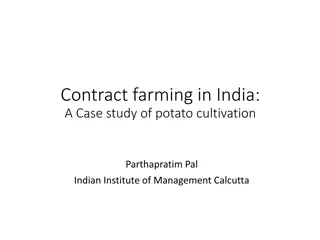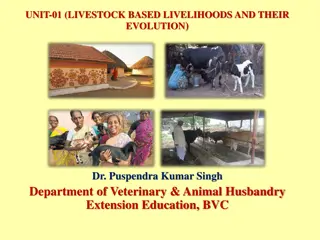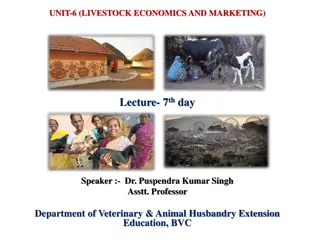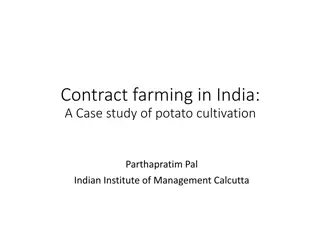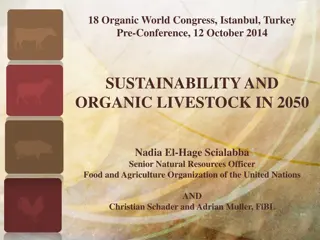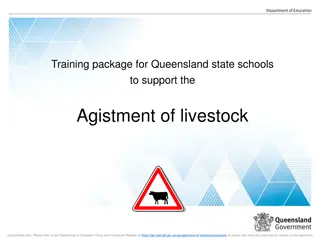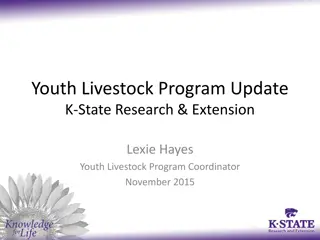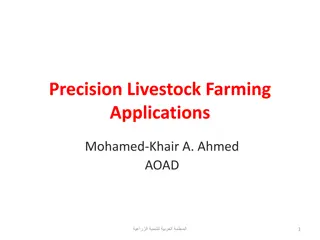Livestock-Based Livelihoods and Farming in India
Livestock-based livelihoods play a crucial role in India, influenced by factors like climate, soil, and economic considerations. Different types of farming, such as specialized, diversified, and mixed farming, cater to varying income sources and ownership structures. Specialized farming offers advantages in efficiency, marketing, and mastery over production conditions, while diversified farming involves multiple income sources within one enterprise. Mixed farming combines crop production with other activities for a comprehensive approach.
Download Presentation

Please find below an Image/Link to download the presentation.
The content on the website is provided AS IS for your information and personal use only. It may not be sold, licensed, or shared on other websites without obtaining consent from the author.If you encounter any issues during the download, it is possible that the publisher has removed the file from their server.
You are allowed to download the files provided on this website for personal or commercial use, subject to the condition that they are used lawfully. All files are the property of their respective owners.
The content on the website is provided AS IS for your information and personal use only. It may not be sold, licensed, or shared on other websites without obtaining consent from the author.
E N D
Presentation Transcript
UNIT-01 (LIVESTOCK BASED LIVELIHOODS AND THEIR EVOLUTION) Dr. Pankaj Kumar Department of Veterinary & Animal Husbandry Extension Education, BVC
Factors determining type of farming Physical factors: Climate Soil Topography Economic factors Relative Profitability Availability of funds Availability of labour & capital Availability of input Land values Marketing costs Marketing facilities Cycles of over & under production Competition between enterprises Personal choices Miscellaneous seasonal availability of raw material, diseases etc. Social factors: Type of community Cooperative spirit
Classification of farming Based on mode of ownership and organization of farms Individually owned Co-operative farming Collective farming Based on how income is derived from a farming enterprise Specialized farming Diversified farming Mixed farming Based on scale of operations Small scale farming Large scale farming
Specialized farming In which 50% or more income/receipts are derived from one source.
Advantages of specialized farming Best suited to particular soil, climate, topography & other physical conditions like market type Work easily get reduced to routine Better marketing Better management Less equipments and labour needed Efficiency & skill of personnel increased Costly & efficient machinery can be kept Farmer can secure complete mastery over the conditions, problems of production, processing & sale Under favourable & specific conditions extremely profitable
Diversified farming When farming is organized to produce one main product but also has several other enterprises each of which itself is the direct source of income
Mixed farming When crop production is combined with livestock production with minimum 10 % & maximum 49 % income derived from livestock farming, entitled as mixed farming
Advantages of mixed / diversified farming Well suited for adoption round the year under Indian conditions Income obtained throughout the year Offer opportunity for better use of land, capital & labour Helps in maintaining soil fertility Reduces the risks due to failure, unfavourable market price etc. Income is regular and quick Cost of transportation and sale of by-products can be reduced to minimum Offer opportunity for complete use of agricultural wastes Provides balanced and protective farming
Co-operative farming In which agricultural/livestock producers co- operate with one another to secure advantages of co-operative buying of inputs & selling of produce or they may co-operate in order to obtain credit on easier terms.
Classification of Co-operative farming societies Co-operative better farming society: Independent land holding members agree to follow a plan of cultivation/operation laid down by the society Co-operative tenant farming society: Leases out the plots to members for individual cultivation Co-operative joint farming society: Land owners pool their lands for joint cultivation. The ownership of each member in his holding continues and is recognized by the payment of dividend in proportion to the value of his land
Collective farming In collective farming societies, members do not have an individual land ownership right in the society s land. Society holds land in free hold or leasehold and undertakes joint cultivation
Types of collective farming societies TYPE I Collective Farming Societies transfer of land ownership rights by members in return for shares of equivalent value Type II Collective Farming Societies transfer of land ownership rights by members without any consideration TYPE III Collective Farming Societies - Absence of the transfer of any prior land ownership rights by members
Large & Small scale farming Different means of describing scale of livestock enterprise: Quantity of produce & marketed unit within a time period Number of animals/ birds maintained Area of holding over which the livestock enterprise is based The advantages of large scale production over small scale production are called Economies of scale
Advantages of Large-scale farming Increased efficiency & full utilization of labour Lower machine cost as a result of greater annual use Building economics Buying and selling Management Economics in financing Economics in the use of by- products
Disadvantages of Large-scale farming Greater losses during depression period Difficulty in supervision Under utilization of resources, equipments, labors Apart from this, extended limit of farm then leads to inefficiencies
Advantages of small scale farming Close attention & supervision Efficient use of family labour Higher productivity Low market dependence for inputs Intensive cultivation is possible Social justice through distribution of landed property Higher family labour employment
Disadvantages of small scale farming Inadequacy of productive resources Unremunerative farming Limited scope for development Shortage of farm implements Under employment Market diseconomies Shortage of finance Relatively more overheads
Comparison between Large & Small scale farming Aspects Large scale Small scale Division of labour Possible Limited Mechanization Possible Not possible Quantity of output More Less Cost of production Low High Cost of management Low High Risk More Less Marketing facilities Better Poor Economy of buying & selling More Less Possibility of using improved technology More Less Danger of over production More Less Supervision Poor Better Flexibility Inflexible Flexible Chances of unhealthy competition More Less
Contract or integrated farming Poultry farmers Provide land, sheds and labour To provide eggs or chicken of certain quality & adhere to management practices indicated by agency Agency Supply of chicks, vaccinations, health care, feed, purchasing the output


